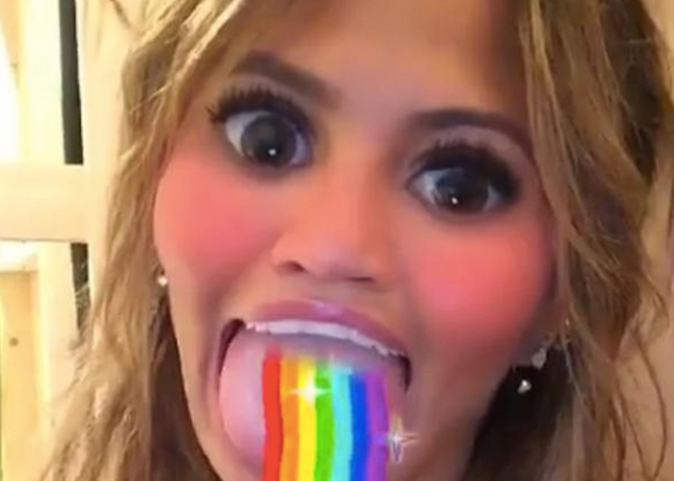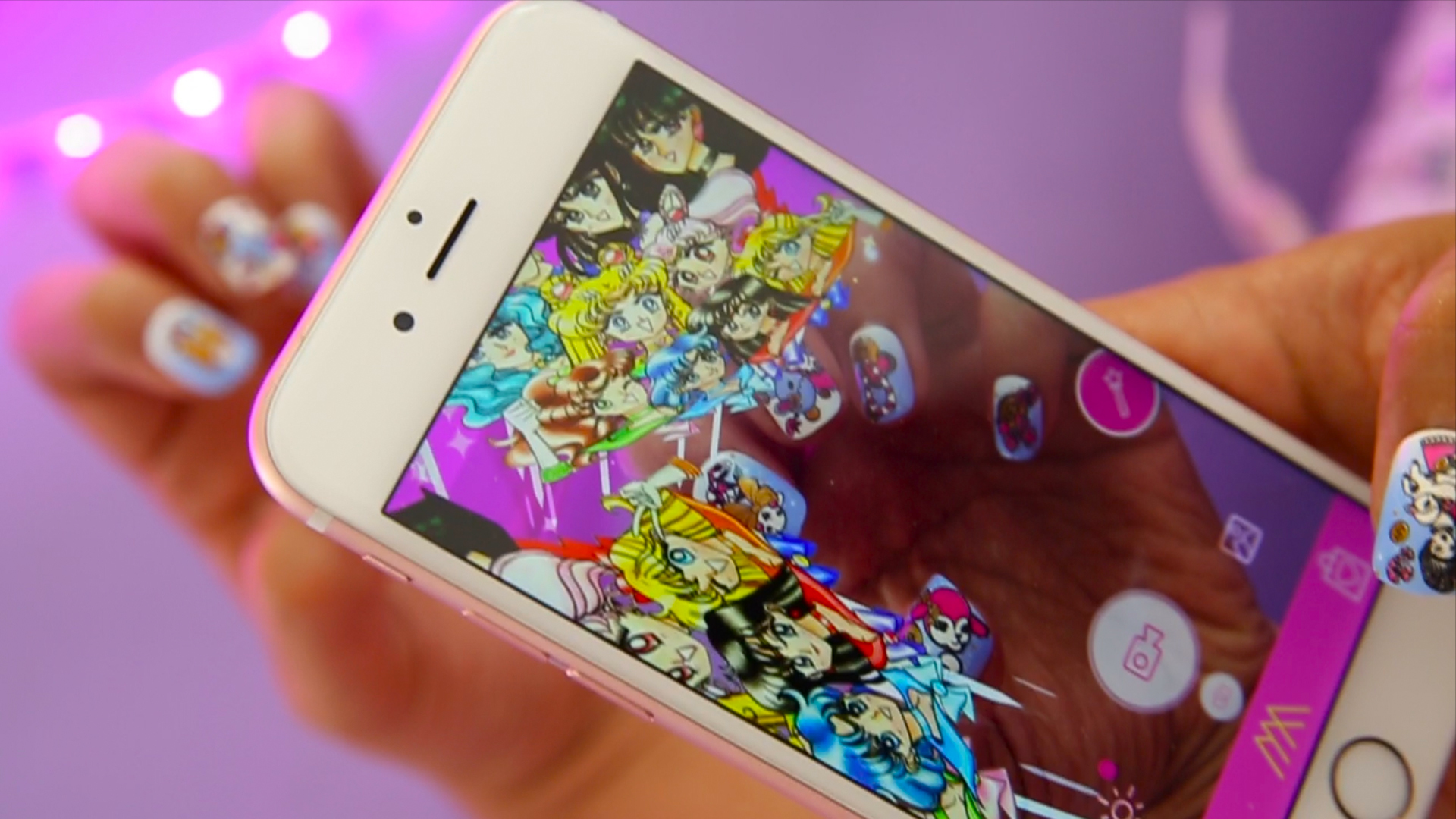There’s an otherwise inconsequential scene in the original Total Recall movie where the receptionist “paints” her nails by tapping each one with a stylus to change it to a perfect glossy scarlet. This was in 1990, just before Arnold Schwarzenegger became a fake kindergarten cop and long before styluses were things attached to smartphones.
Two-and-a-half decades later and the virtual manicure doesn’t sound quite so insane. When “digital makeup artist” MODA first caught the internet’s attention at the beginning of 2014, it was approached with the disclaimer that it could be an early April Fools’ joke due to its suspicious timing and literally unbelievable capabilities. Essentially the makeup version of Cher’s virtual wardrobe in Clueless — now also a thing — MODA allows the user to select a full beauty look from a library of pre-set makeup combos. No idea what suits your own facial features? The “Uniquely You” mode can suggest a look that will. No hand-eye coordination? No problem. After deciding on your look, stick your face into what looks like a turn-of-the-millennium iMac and it will be 3D-printed — from primer to contour to neon lipstick — onto your face in just 30 seconds.
ModiFace is essentially the same product minus the 3D-printing, and potentially even more interesting in its comparative simplicity. The crazy thing about ModiFace is that exists only on your iPhone (at least for now). But the technology isn’t just a way to buy a new foundation without smearing 30 different tester products onto your skin under the watchful eyes of retail associates. One feature allows users to change boring old human irises into flickering flames. Another swipe of the forefinger can simulate lip enhancement, alienesque eyes, or emoji-style video effects. “At ModiFace we are always looking to expand our technology offerings and do internal trials of new effects and features,” says the brand’s Director of Partnerships, Jennifer Tidy. “Having wild options like flames for your irises, or cartoon-like features, is a fun aspect of the technology. We are just showcasing that the technology can be for fun as well as serious uses.”

A look at the most rapturous reviews proves that this might be exactly what younger customers are looking for. “It’s just great for colored contacts and the makeup and just seeing how you would look if things on your face were to be changed. I’m very satisfied!,” writes user BabyCardinal. Another review deems ModiFace “the ultimate selfie app.” In this way it resembles the expanding range of outré filters currently permeating Snapchat, an app used by about 30 percent (and counting) of millennial U.S. internet users. While Instagram airbrush filters have so far spawned approximately a million think pieces for their apparently damaging effect on self-confidence, Snapchat’s drag or anime-eyes filters are so wild it’s difficult to make a similar argument.
But what about people becoming so engrossed in their augmented experiences that they lose interest in their real ones? This also arguably misses the point. The ability to reconfigure the code of one’s appearance has long been exploited by communities marginalized by mainstream beauty ideals. In recent decades we’ve moved away from the archaic idea that neon hair and visible tattoos are symbols of internal depravity — can’t an iPhone also be used to send 3D digital messages about experimentation and identity?
On a recent trip to New York, Thea Mai Baumann, the Shanghai-based CEO of Metaverse handed out single-nail samples of her virtual reality product to local kids at a queer dance party. The app-activated makeover proved a massive hit with the colorful crowd. “Since the genesis of the company and brand, Metaverse has always been floated by a supportive network of queer users, artists, collaborators, and personalities tapping into and expressing themselves through this AR platform,” Baumann tells us over email from Los Angeles. She’s about to launch the next chapter of the Metaverse takeover through a series of collaborations with artists such as Arvida Byström and Ambar Navarro. Navarro has just created a trippy new video commercial for the brand. “The Metaverse brand sprung from early experiments with virtual technologies and collaborators such as queer performance artist/dancer Shian. I’ve even created certain collectable holograms inspired by Shian’s ever changing fluoro hairstyles. We’re really all about pushing at the spectrum of your online-offline identity — beauty as ‘prismatic’ — in scope and perception.”

There’s another, more obvious way that these products can empower younger customers and ones from marginalized communities, and that’s by virtue of being basically free. Metaverse’s nail decals go for around the price of a good sandwich, and last a lot longer. The app is free, as is ModiFace’s. “For those customers who like cosmetics, financial reasons or not, being able to simulate beauty products on yourself and do selfie touch-ups has no financial risk,” explains Tidy. “This type of technology is to empower the customer to want to purchase products, but it is also there to explore and learn more about a brand, have fun with the AR simulations and be educated on possible purchasing decisions.” It might also give customers the opportunity to pass up the in-store process entirely. While Sephora is like Disneyland for many young adults, experimenting with unconventional looks is more of a struggle when you already don’t fit the stereotype of an upwardly mobile makeup shopper — or might not have the money to buy a single lipstick. In a multi-billion dollar industry, augmented and virtual experiences can bring beauty back to self-expression rather than dollar signs.
Being able to alter your appearance at the touch of a button does, though, raise a few questions when it comes to age, gender, and race. Snapchat’s unfortunate Bob Marley filter, which resulted in the app being called out for sanctioning blackface, is just the tip of an iceberg that also includes the inability of some technologies to recognize darker skin. These controversies expose the entire tech industry’s racial blind spot, but what about things like augmenting one’s skin color or eye shape? No one can control how customers use reality-skewing beauty apps — that’s the beauty and the danger of them. But what’s reassuring about many of these products is that they’re being developed by people with the ability not just to flag problematic functions before uploading them to the app store but to spotlight gaps in the market. “If pushing your features through 10 filters makes you feel like you’ve reached your ultimate self, then do it. If contouring your way to highlighted Himalayan heights is your thing, then do it,” says Baumann. “I guess it really becomes problematic when the hyper filtered glow and the giant manga Meitu eyes and aquiline contouring becomes the baseline standard for beauty in real lIfe.”
Grace Choi is another using tech to make beauty more inclusive. Choi worked at Burger King before developing her own revolutionary 3-D makeup printer, Mink, and is aiming to tackle the beauty industry racism that persists thanks to the insane cost of developing more than a handful of foundation shades.”The challenges are diversity issues and issues with women’s confidence,” she said after her product first floored the internet in 2014. “My wish is that the idea that beauty is in the control of the person… the man or the woman, the user, and that’s it, and nobody else. It’s not about the beauty company or your mom or whoever saying ‘This is beautiful’ or ‘This is right’ or ‘This is wrong.’ No. It’s your decision to decide what’s pretty or not.” Just look at the backlash over Kanye West’s wolf-like blue contacts at the Met Gala on Monday. Extreme change doesn’t have to be about assimilating but can be about assuming the look of another species entirely.
This is the transformative power of beauty that we thought was fun as kids, before “nontouring” was even a thing let alone part of our vocabulary. “Everyone needs to relax on achieving the unattainable,” says Baumann. “Especially when beauty is beyond constructed and simulated.” Screw perfection — maybe we just want trippy nail wands like the ones promised in 1990.
Credits
Text Hannah Ongley
